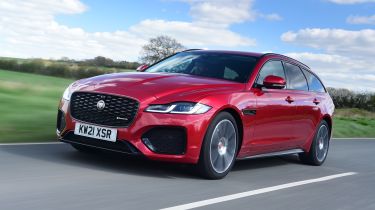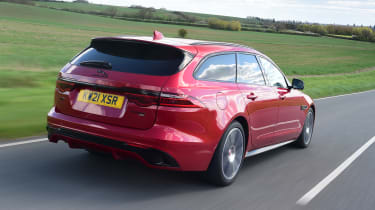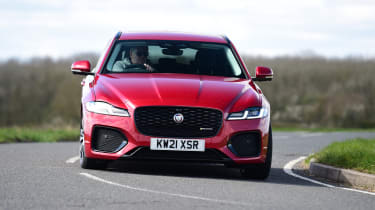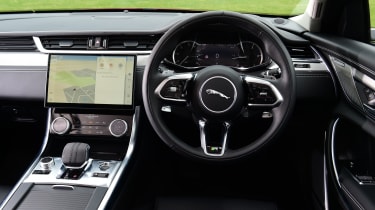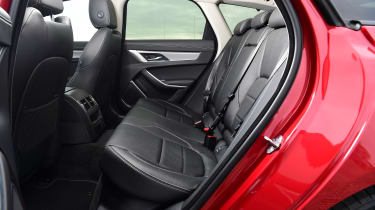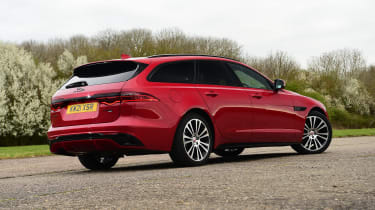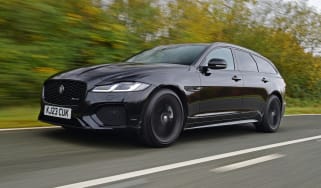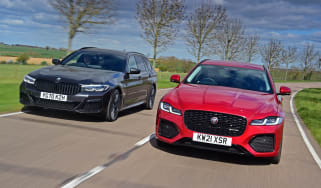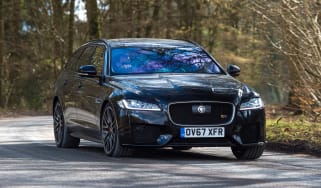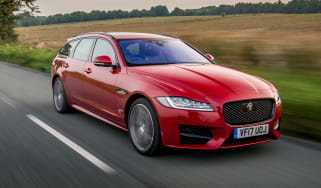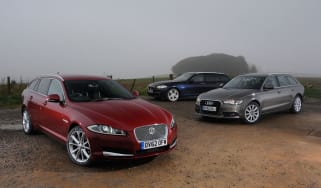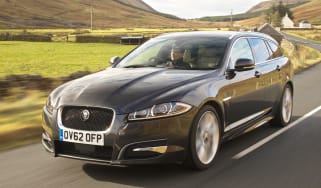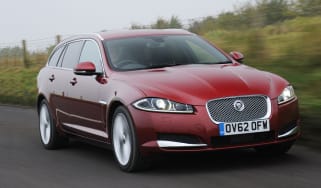Jaguar XF Sportbrake review
The Jaguar XF Sportbrake is a decent match for any rival in this sector, although a lack of plug-in hybrid tech counts against it

You’d be forgiven for thinking the world was obsessed with crossovers and SUVs, but the Jaguar XF Sportbrake is proof that there’s the life in the estate car yet. Launched in mid-2017, the new XF Sportbrake is the perfect antidote for those who haven’t bought into the whole crossover-SUV thing.
What the XF Sportbrake gives up to the F-Pace in terms of a commanding driving position and fashionable appeal, it more than makes up for in terms of luggage capacity and driver fun. In fact, despite the lack of an efficient plug-in hybrid model, the wagon feels more in tune with Jaguar’s old adage of grace, pace and space.
About the Jaguar XF Sportbrake
The original XF was launched at the 2007 Frankfurt Motor Show, replacing the ageing and Ford-based Jaguar S-Type. The first XF Sportbrake was revealed in 2012 before an all-new XF arrived towards the end of 2015. A further refresh in 2021 included exterior tweaks, a plusher interior and updated on-board tech.
The Sportbrake – Jaguar’s fancy name for an estate car – offers a practical 565 litres of boot space, which can be extended to 1,700 litres with the rear seats folded flat. Rivals include the equally cavernous Audi A6 Avant, BMW 5 Series Touring and Mercedes E-Class Estate. It’s based on the XF saloon and costs around £2,000 more across the range.
The engine range consists of a single D200 2.0-litre, four-cylinder diesel unit, producing 201bhp, or a 2.0-litre petrol with either 247bhp (P250) or 296bhp (P300). There is a choice of rear- or all-wheel-drive, with an eight-speed automatic transmission as standard.
Used - available now

2022 Volvo
XC40
37,000 milesAutomaticPetrol1.5L
Cash £21,329
2021 Kia
Sportage
32,990 milesAutomaticPetrol1.6L
Cash £18,119
2023 Nissan
Juke
16,200 milesAutomaticPetrol1.6L
Cash £17,238
2022 MG
HS
14,218 milesAutomaticPetrol1.5L
Cash £17,096There are four trim levels available, although they're not all offered with each engine option. The entry R-Dynamic S specification is combined with the P250 unit only, while R-Dynamic SE comes with the choice of the petrol P250 or diesel D200 variants. R-Dynamic HSE is the only trim you'll find across the whole range, while the D200 also includes a one-off R-Dynamic Black edition.
Anyone who thought Jaguar had turned its back on the estate car segment should take a look at the latest XF Sportbrake. The large estate car is stylish, good to drive and offers an impressive amount of pace – even in the entry-level diesel models. The cavernous load area is a match for all but the Mercedes E-Class Estate, while the interior offers more space than the old model. The driving position is superb, while the updated interior and tech are a vast improvement over the pre-facelift model.
Engines, performance and drive
Like the XF saloon, the Sportbrake is based on a lightweight aluminium architecture, which helps the way it rides and handles. In fact, with the estate version weighing just 115kg more than the saloon, you’d be hard-pressed to notice any difference at the wheel.
That’s high praise indeed. All Sportbrake models feature air suspension at the rear, which helps to ensure a level chassis and ride height, even when the car is fully laden. No chance of the freshly purchased pot plants, or worse still, the golden retriever, enjoying a less than perfect ride home from the garden centre, then.
In fact, the XF Sportbrake offers a near-perfect blend of comfort and dynamics. Upgrading to 20-inch alloy wheels will have next-to-no impact on the ride quality, such is the cushion-soft ride.
But show the XF Sportbrake a twisting B-road, and it’ll respond with lightning-quick cornering, tight body control and bags of grip, especially if you opt for one of the all-wheel drive models. Flick the suspension into Dynamic mode, and the Sportbrake fidgets around a little more, but rarely feels too firm. The car appears more alive and more eager to change direction in this mode.
The perfect sporting estate, then? It’s undoubtedly one of the best-in-class when it comes to ride and handling, with only a small amount of additional road noise over the saloon. Still want that F-Pace?
Engines, 0-60 acceleration and top speed
Jaguar had company car drivers in mind when it developed the XF Sportbrake, which is why the engine line-up consists predominantly of low-emission four-cylinder units.
The 201bhp 2.0-litre four-cylinder diesel is likely to be the most popular choice and now benefits from mild-hybrid technology. Motorway driving is a smooth and relaxing affair, while the paddle-shifters on the steering wheel can be used to inject some enjoyment when the occasion arises. During our test we found the need to rev the engine higher to access peak power, while the all-wheel-drive system provided good traction out of corners and could be a little more reassuring in poor weather conditions. Jaguar claims a 0-62mph time of 8.0 seconds for the oilburner.
Moving up to the more powerful P250 and P300 means improved performance, with sprint times of 6.9 seconds and 6.1 seconds, respectively.
MPG, CO2 and Running Costs
Jaguar has updated its 2.0-litre diesel engine with mild-hybrid tech, so the rear-wheel-drive model is claimed to average 49.6mpg according to WLTP testing, with CO2 emissions of 150g/km. If you opt for 4WD then you'll see economy of 54.3mpg with 137g/km of CO2.
The petrol P250 will obviously not match the diesels for efficiency, managing 34.0mpg and 188g/km of CO2, while the 296bhp P300 will struggle to average more than 32mpg and emit between 204g/km and 218g/km.
Business users, running a RWD diesel model, will incur a BiK tax rate of 34 per cent for 2021/22.
Insurance groups
Insurance premiums for the XF Sportbrake won't be particularly cheap, with the entry D200 SE and P250 S versions in group 36. Moving up to HSE trim means a one place climb to group 37, while the top-spec P300 HSE sits in group 40. In comparison, the BMW 5 Series Touring starts in group 32 for the 520i SE petrol.
Depreciation
The XF Sportbrake will hold on to anywhere between 45 and 49 per cent of its value after three years and 36,000-miles, which is similar to the BMW 5 Series Touring, although just shy of the Mercedes E-Class Estate.
Interior, design and technology
The Sportbrake is identical to the saloon until you reach the B-pillar, where the roofline stays high and continues past to the rear to reveal a traditional estate car back-end. The tailgate is dominated by the F-Type-inspired rear light clusters.
To our eyes, this is the best-looking estate car you can buy, even managing to steal a march over the Volvo V90, especially in top-spec S trim. It’s sharper than before, with neat touches such as the F-Pace-inspired rear window and the taillights mentioned above.
As you’d expect, the cabin is identical to the saloon, with both benefiting from the a refresh in 2020. Standard kit includes 12-way heated electric front seats, trimmed in perforated DuoLeather, while there’s a new steering wheel that’s carried over from the I-Pace SUV that looks and feels a quality item. A black headlining and plenty of aluminium trim finish off a much improved cabin.
The driving position is suitably sporty, helped by the raised centre console, which provides a terrific sense of occasion, while the optional panoramic sunroof allows light to flood into the cabin. At £1,125, it’s an expensive but must-have option.
Sat-nav, stereo and infotainment
Jaguar engineers and designers have clearly spent most of their time creating a truly fresh interior for the XF.
The cabin includes a totally redesigned centre console, with a new 11.4-inch curved glass touchscreen taking pride of place. The screen controls Jaguar’s Pivi Pro infotainment system, which features sharper graphics and a more polished, user-friendly interface, which now adds most key navigation, climate and audio functions onto the main display.
Apple CarPlay and Android Auto are both standard, while a 400W Meridian audio system is offered with the HSE trim level.
Practicality, comfort and boot space
The XF Sportbrake’s undoubted good looks don’t come at the expense of practicality, as the Jaguar estate is a match for the majority of its rivals, with only the all-conquering Mercedes-E-Class Estate providing more interior space.
A detachable tow bar can be fitted for £705, or, for an additional £285, you can upgrade to an electrically deployable version. The towing capacity is rated at 1,900kg to 2,000kg, depending on the engine.
Size
At 4,955mm in length, the XF Sportbrake is only 1mm longer than the saloon and 22mm longer than the Mercedes E-Class Estate. At 2,091mm width and 1,496mm height, it’s also slightly wider and taller than the E-Class.
Leg room, head room & passenger space
The previous generation XF Sportbrake was criticised for the lack of rear legroom, but this isn’t an issue in the latest model. All but the very tallest of passengers will also find plenty of headroom in the back, while entry to the rear seats is much improved, thanks to the large rear doors.
Boot
If you’re buying an estate car, the load capacity will be an important consideration. At 565 litres, the XF Sportbrake offers only 25 litres more than the saloon, but the space is more usable due to its square shape.
The optional electric tailgate opens to reveal a huge opening, while the 40:20:40-split rear bench folds flat to create a totally flush load area and up to 1,700 litres of capacity.
At 640 litres, the Mercedes E-Class Estate offers a larger load area, while the XF is five litres smaller than a BMW 5 Series Touring, but five litres bigger than the Volvo V90.
Reliability and Safety
The Sportbrake hasn’t been tested by Euro NCAP, but the XF saloon received a five-star safety rating in 2015. The scores were impressive across the board, including 92 per cent for adult occupants, 84 per cent for child occupants, 80 per cent for pedestrian safety, and 83 per cent for safety assist systems.
There’s an impressive list of standard safety equipment fitted across the range, including autonomous emergency braking, lane departure warning, trailer stability assist, traffic sign recognition and rear parking aid.
Options include a surround camera system (£990), lane keep assist (£480), blind spot monitor and reverse traffic detection (£525) and park assist (£470).
Although the XF didn't appear in our 2021 Driver Power customer satisfaction survey, Jaguar itself finished in an impressive seventh place (out of thirty brands) in the Best manufacturer poll - up from twelfth spot in 2020.
Warranty
The XF Sportbrake comes with a standard three-year, unlimited mileage warranty, which is on par with rivals in this sector. This can be extended for up to 12 months, with a package that includes MOT test insurance cover and car hire for seven days.
Servicing
In line with some other brands, Jaguar offers flexible service plan for the XF Sportbrake, priced according to the annual mileage and engine type.
If you're thinking of buying a Jaguar XF Sportbrake, why not visit our Find a Car service for the latest deals...
